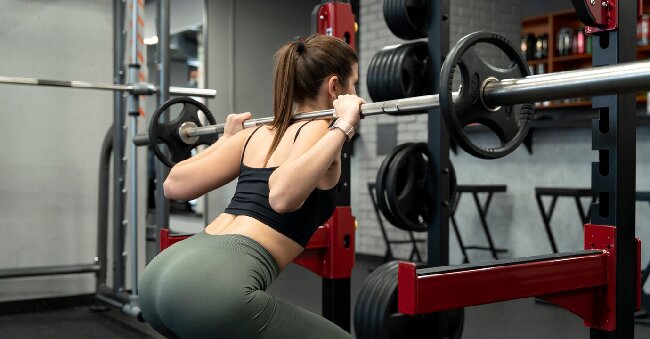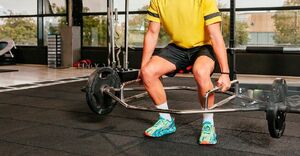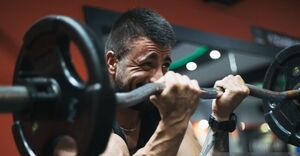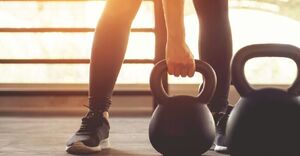
Scientific Application of Squat Machines: Avoiding Common Mistakes and Injuries
Squat machines are a popular choice for lower body workouts, but using them incorrectly can lead to injuries. In this article, we will explore the different types of squat machines and how to use them properly.
This includes correct foot placement, body alignment, and engaging core muscles. We will also discuss the common mistakes to avoid and the most common injuries associated with squat machines.
Additionally, we will provide tips on how to avoid injuries and alternative exercises to try. If you want to make the most out of your squat machine workout and prevent injuries, keep reading!
What Are Squat Machines?
Squat machines are gym equipment designed for lower body exercises, employing biomechanics and weightlifting principles to enhance the effectiveness of leg and glute workouts.
Squat machines are designed to offer stability and support during squats, enabling targeted muscle group engagement through controlled movements. These machines provide resistance, aiding in the strengthening and toning of the quadriceps, hamstrings, and glutes. With adjustable settings and diverse foot placements on the platforms, individuals can tailor their workouts to their fitness level and objectives. Including squat machines in a weightlifting routine can contribute to developing lower body strength and improving athletic performance.
What Are The Different Types of Squat Machines?
When it comes to weight training, there are various machines available for squats. One popular option is the traditional barbell squat rack, known for its ability to handle heavy weights and support a wide range of lower body exercises. This makes it a great choice for those looking to build muscle and focus on powerlifting.
Another type of squat machine is the lever squat machine, which offers a more controlled resistance. This makes it ideal for targeting specific muscles and for rehabilitation exercises.
Cable-based squat machines are also available, providing variable resistance through pulley systems. This allows for fluid and continuous movements, making them a great fit for functional training and conditioning programs.
How To Use Squat Machines Properly?
Proper utilization of squat machines involves mastering the exercise technique, ensuring optimal muscle activation, addressing muscle imbalances, prioritizing safety measures, and preventing potential injuries through correct body alignment.
Correct Foot Placement
Achieving correct foot placement on a squat machine is essential for maintaining proper form, optimizing muscle recruitment, ensuring adequate range of motion, and aligning with sound body mechanics.
Proper foot placement is crucial for maintaining a stable and balanced posture. This helps to evenly distribute the load across the lower body and engage major muscle groups like the quadriceps, hamstrings, glutes, and calves. With correct foot positioning, the body can move through exercises with a full range of motion, reducing strain and risk of injury. This also improves the effectiveness of workouts.
Proper Body Alignment
Maintaining proper body alignment during the use of squat machines is crucial for facilitating muscle coordination, optimizing loading mechanics, correcting exercise form, and supporting stability training.
Ensuring correct alignment helps in engaging the targeted muscle groups effectively, preventing unnecessary stress on joints, and promoting efficient movement patterns. Proper alignment also aids in correcting any deviation from the ideal squat form, reducing the risk of injury while enhancing overall exercise effectiveness.
It plays a significant role in stability training by promoting balanced weight distribution and controlled movements, thereby enhancing the overall control and stability of the body during squat exercises.
Engaging Core Muscles
Engaging the core muscles while using squat machines is essential for maintaining correct posture, managing muscle tension, reducing injury risk, exercising caution, and promoting overall muscle strengthening.
Engaging the core muscles during squat machine exercises has numerous benefits. It effectively stabilizes the spine and pelvis, ensuring proper alignment and reducing the risk of lower back injuries. This engagement also helps distribute the load evenly across the body, reducing strain on any single muscle group.
Strengthening the core muscles is crucial for overall stability and balance during the exercise. This helps prevent falls and promotes a holistic approach to muscle strengthening. By properly engaging the core muscles, the body is well-supported and protected throughout the squat machine workout.
What Are The Common Mistakes When Using Squat Machines?
Certain common mistakes when using squat machines can lead to exercise-related injuries, muscle strain, discomfort, and pain, often attributed to incorrect muscle activation patterns and exercise-related discomfort.
Improper alignment of the knees, hips, and spine can increase the risk of injury and strain on muscles. This can be caused by errors such as using excessive weight or incorrect form, resulting in discomfort and pain in the lower back, knees, or hips.
Additionally, failing to engage core muscles can lead to inadequate support for the spine and increase the risk of injury. By being aware of these common mistakes and prioritizing proper form and muscle activation, the risk of exercise-related discomfort and injury when using squat machines can be reduced.
Improper Foot Placement
Improper foot placement on squat machines can compromise muscle activation, jeopardize exercise safety, and necessitate injury management strategies, prompting the need for exercise technique analysis.
This improper positioning can lead to insufficient engagement of the targeted muscles, reducing the effectiveness of the exercise. It increases the risk of strain or injury to the knees, hips, and lower back, highlighting the importance of proper foot alignment.
Understanding the implications of improper foot placement is crucial for preventing potential injuries and optimizing workout outcomes. Therefore, trainers and fitness enthusiasts must prioritize proper foot positioning and technique analysis to ensure safe and effective squat machine workouts.
Incorrect Body Alignment
Incorrect body alignment when using squat machines can heighten the risk of injuries, lead to exercise-related strain, trigger muscle imbalances, and contribute to exercise-related stress on the body.
This misalignment can result in excessive pressure on certain muscle groups, leading to overuse injuries and strain. Imbalanced loading on muscles due to improper alignment can cause muscle imbalances, which may predispose individuals to various musculoskeletal issues.
The added stress on the body from incorrect alignment can impact the overall stability and functionality of the muscles, potentially compromising the effectiveness of the workout and increasing the likelihood of injury.
Not Engaging Core Muscles
Failure to engage core muscles during squat machine exercises can undermine injury prevention efforts, compromise stability training, and contribute to exercise-related soreness, impacting overall muscle coordination.
Neglecting the activation of core muscles can lead to decreased stability during the squat movement, increasing the risk of strains and sprains.
Without the support of the core, improper weight distribution shifts the workload to other muscle groups, often resulting in muscular imbalances and potential injuries. A weak core can lead to poor form, diminishing the effectiveness of the exercise and potentially exacerbating post-workout soreness.
What Are The Most Common Injuries Associated With Squat Machines?
Prominent injuries linked to squat machines encompass knee injuries, lower back injuries, shoulder injuries, and other exercise-induced injuries that warrant careful attention and preventive measures.
Improper form, excessive weight, or overexertion during squats can lead to injuries. Common knee injuries, like patellar tendinitis or meniscus tears, can be caused by poor alignment or lack of warm-up. Lower back injuries, such as strains or disc herniation, may result from overarching or rounding the back. Shoulder injuries, such as impingement or rotator cuff strains, can stem from improper positioning or too much weight. To prevent these injuries, it’s important to focus on proper form, use appropriate weight, and incorporate warm-up and mobility exercises.
Knee Injuries
Knee injuries associated with squat machines can manifest as exercise-related discomfort, muscle imbalances, increased injury risk, and may necessitate rehabilitation protocols to aid in recovery and prevention.
The repetitive movements and heavy loads during squat exercises can place excessive strain on the knee joint, potentially leading to overuse injuries such as patellar tendonitis or ligament sprains.
Muscle imbalances, particularly between the quadriceps and hamstrings, can further exacerbate the risk of injury. Rehabilitation programs often focus on strengthening the supportive muscles, improving flexibility, and correcting movement patterns to address these issues and facilitate a safe return to squatting activities.
It’s important to recognize and address any discomfort or imbalances to prevent long-term complications.
Lower Back Injuries
Lower back injuries stemming from squat machines require comprehensive body mechanics assessment, entail exercise-related strain, and demand tailored injury management strategies, often integrated with strength and conditioning programs.
Individuals experiencing lower back injuries from squat machines often face challenges in proper body alignment and weight distribution during the exercise, which can exacerbate strain on the lumbar region.
Proper form and technique assessment are crucial in identifying any deviations that may contribute to the injury. Tailored injury management strategies may include a combination of targeted strengthening exercises, flexibility training, and gradual progression in the intensity of workouts to prevent re-injury and promote long-term recovery.
Shoulder Injuries
Shoulder injuries resulting from squat machines implicate joint stability, elicit exercise-related pain, necessitate refined exercise execution, and may involve targeted muscle strengthening approaches.
Maintaining proper joint stability during squat exercises is crucial to prevent shoulder injuries, as instability can place excess strain on the shoulders.
Exercise-related pain in the shoulders during squats often signals improper form or muscle imbalances. Refining the execution of squats by focusing on activating the shoulder stabilizing muscles can alleviate the risk of injury and improve overall performance.
Targeted muscle strengthening strategies, such as incorporating specific shoulder exercises into the training regimen, can help fortify the shoulder muscles and support joint stability during squat movements.
How To Avoid Injuries When Using Squat Machines?
Preventing injuries during the use of squat machines involves thorough warm-up routines, adherence to proper form, and avoiding overloading, all aimed at mitigating exercise-related strain and incorporating injury management strategies.
To begin, a dynamic warm-up that includes movements to increase body temperature and activate muscles is crucial.
This can include light cardio, dynamic stretching, and mobility exercises.
During the squat, it is essential to maintain proper form, ensuring that the knees track over the toes and the back remains straight.
Overloading the squat machine with excessive weight should be avoided to prevent unnecessary strain.
Paying attention to any signs of discomfort and incorporating rest periods are also vital in injury prevention.
Warm-Up Properly
Engaging in a proper warm-up routine prior to using squat machines is crucial for reducing exercise-related soreness, lowering injury risk, minimizing exercise-related discomfort, and aligning with principles of exercise physiology.
Neglecting warm-up exercises can lead to stiff muscles and increase the risk of injury. A proper warm-up increases blood flow to the muscles, reducing soreness and discomfort during and after exercise. It also prepares the central nervous system for the activity, optimizing movements and coordination during squats, thus minimizing the risk of injury. This aligns with exercise physiology principles, promoting efficient muscle functioning and overall performance.
Use Proper Form
Adhering to proper form when using squat machines optimizes muscle activation patterns, ensures exercise safety, supports stability training, and minimizes exercise-related stress on the body.
Maintaining the correct body positioning during squats is crucial for engaging targeted muscles and reducing the risk of injury. This includes keeping the chest up, aligning knees with toes, and pushing hips back. Proper form promotes stability and prevents strain on joints, ultimately enhancing the exercise’s effectiveness and contributing to overall strength and endurance.
Avoid Overloading
Avoiding overloading on squat machines is essential for preventing exercise-related strain, supporting injury prevention measures, optimizing muscle coordination, and minimizing exercise-related stress on the body.
This mindfulness towards overloading not only helps in preventing muscle strain but also contributes to maintaining proper form and technique during the exercise.
By keeping the load within a manageable range, individuals can also reduce the risk of joint and ligament injuries. Avoiding overloading allows for better focus on engaging the targeted muscles, leading to more effective workouts and overall fitness gains.
It also plays a crucial role in promoting balanced and controlled movements, reducing the occurrence of sudden jerks or uncontrolled motions that can result in injury or discomfort.
What Are The Alternative Exercises To Squat Machines?
Several alternative exercises to squat machines exist, including bodyweight squats, dumbbell squats, and barbell squats, each offering unique variations in exercise execution and targeting specific muscle groups.
Bodyweight squats are a great way to strengthen the lower body using just the weight of your own body. They engage the quadriceps, hamstrings, glutes, and even the core muscles, making them a comprehensive lower body exercise.
Dumbbell squats, on the other hand, add an element of resistance, providing an opportunity to increase the challenge for muscle growth. Barbell squats are known for their effectiveness in activating the entire lower body and are favored for building strength and muscle mass. Each variation contributes to a well-rounded lower body workout.
Bodyweight Squats
Bodyweight squats offer a practical alternative exercise, emphasizing exercise technique, muscle activation, safety considerations, and facilitating a full range of motion.
Bodyweight squats engage multiple muscle groups, including the quadriceps, hamstrings, glutes, and core, by emphasizing proper form and controlled movement. This promotes lower body strength and stability while reducing the risk of strain or injury, making it a safe option for people of all fitness levels.
The customizable nature of bodyweight squats allows for adjustments in depth and foot positioning, allowing individuals to optimize their range of motion and target specific muscle groups. This makes it an effective addition to any workout routine, promoting overall strength and muscle development.
Dumbbell Squats
Dumbbell squats serve as an effective alternative exercise, supporting resistance training, promoting muscle coordination, facilitating exercise form correction, and contributing to overall muscle strengthening.
Incorporating dumbbell squats into your workout routine engages multiple muscle groups at once, including the quadriceps, hamstrings, glutes, and core stabilizers. The added resistance from the dumbbells challenges your muscles, leading to improved strength and endurance.
The need to stabilize and control the dumbbells also enhances muscle coordination and balance. Additionally, performing dumbbell squats with proper form can help correct any imbalances or weaknesses, leading to better overall performance in various activities and reducing the risk of injury.
This exercise is versatile, scalable, and highly beneficial for individuals of all fitness levels.
Barbell Squats
Barbell squats represent a foundational alternative exercise for strength training, necessitating careful injury management strategies and addressing exercise-related discomfort to optimize their effectiveness.
This exercise engages multiple muscle groups, including the quadriceps, hamstrings, and glutes, contributing to overall lower body strength.
To mitigate discomfort, individuals should focus on maintaining proper form and alignment, ensuring that the knees do not extend beyond the toes.
Gradual progression in weight and reps, along with adequate rest between sets, can aid in managing any initial discomfort.
Implementing a comprehensive warm-up routine to prepare the muscles and joints is also instrumental in injury prevention and performance enhancement.




No Comments